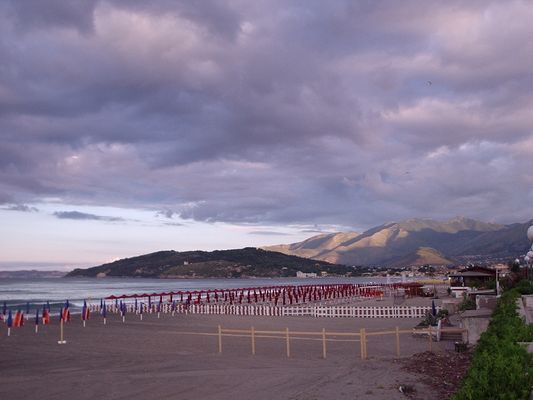This coastal town in Lazio sits on dramatic cliffs above the Tyrrhenian Sea. Medieval streets wind past the 13th-century castle and Saint Erasmus Cathedral.
Gaeta rises on a promontory between Rome and Naples, with its medieval streets leading to an Angevin-Aragonese castle. Walk along Serapo Beach's golden sand, climb the 300 steps to the Grotta del Turco cave, or explore the split crevices of Monte Orlando. In the evening, stop at a local trattoria to taste tiella, the town's double-crusted seafood pie, and sample the famous black olives that carry Gaeta's name around the world.
Getting to Gaeta
Take a train to Formia station, then catch a 15-minute bus ride to Gaeta. The town is 133 km from Rome and 96 km from Naples, making it possible to visit as a day trip from either city. Local buses run every 30 minutes between Gaeta and nearby towns and beaches.
Beaches Along the Gulf
Serapo Beach extends along the town's main waterfront, with fine golden sand and clear shallow waters. You can rent sunbeds at private beach clubs or use the free public areas. Head to Sant'Agostino Beach north of the town center for a calmer experience, even during summer weekends.
Exploring Monte Orlando
Walk the trails of Monte Orlando Park through pine trees and Mediterranean shrubs. At the summit, you'll find the 1st-century mausoleum of Roman general Lucius Munatius Plancus. The Montagna Spaccata (Split Mountain) contains three deep crevices, which local legend links to the crucifixion of Christ. Climb down 300 steps to reach the 930 CE Sanctuary of the Most Holy Trinity and the Grotta del Turco cave built into the rock face.
Medieval Streets and Architecture
Walk through the Medieval Quarter's narrow alleys and small porticoes, enclosed by the walls of the Angevin-Aragonese Castle. Along Via Indipendenza, you'll pass iron balconies and small shops selling local products. Stop at the small squares to watch local life unfold at cafes and restaurants.
Local Food and Traditions
Try tiella at local bakeries - this double-crusted pie comes filled with octopus, seafood, vegetables, or escarole. Buy local black olives from street vendors or food shops. In December, taste Christmas sweets like sciuscielle (honey-covered nuts) and mostaccioli (spiced cookies). On December 31st, join the Glie Sciusce festival where locals wear traditional costumes and play handmade instruments in the streets.
Religious Buildings
Step into the Cathedral of Assunta e Sant'Erasmo to see its Arabian-Norman bell tower from 1279. Visit the Church of San Giovanni a Mare, built with a sloping floor that drains high tide waters. Inside the 14th-century Sanctuary of Santissima Annunziata, look for ancient musical manuscripts preserved in the Golden Grotto.




















